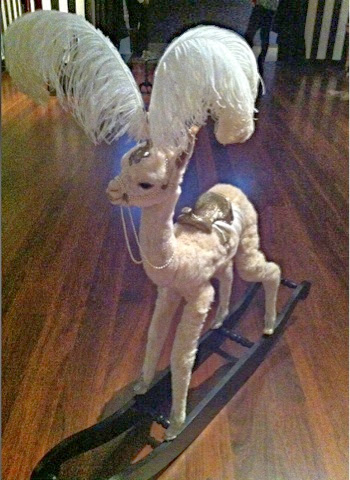Most of my time was spent going through the Dark Heart exhibit, as paintings of fruit and portraits of unattractive rich people gets tiring. I did walk through the whole gallery, but did so rather quickly. I'm certain that I missed some famous pieces of artwork in the process. (Sorry Mom) I only gave my attention to things that caught my own interest. I didn't record the artists or information of most of these either.
There were a few rooms which focused quite a bit on aboriginal artwork, of or by indigenous people of Australia. There were a few head casts of aboriginal men and paintings of the scenery of their land.
There was one room with chairs facing three large screens. Each screen projected movies. To the left and right, the footage was of varying wild landscapes. In the front of the room was a long video showing many indigenous women sitting along a huge blank canvas, painting intricate designs on their individual sections. I watched a for few minutes and then continued down the path behind the main screen. On the other side was the completed painting shown in the video. A sign explained that this painting was a detailed map of their land and compared it with a remarkably similar aerial view.
As I entered the Dark Heart exhibit, the artwork took on much more politically charged meanings.
"eX DeMedici: Inspired by the artist's recent visits to Iran, the work merges global brands representative of multinational corporations into a modified pattern from the Golestan Palace."
This was a wall of political leader portraits with parts of their face covered with black spray paint.
"Kathryn Barton: The painting introduces the 'dark heart' of the exhibitions title which appears in the centre of the painting and beats in the exposed chest of an onlooking marsupial."
The next room was set up as a baby's nursery and filled with lavishly decorated taxidermied animals. The sign explained how the artist, Julia DeVille, was inspired by a fox skin a family member had hanging over a mirror for decoration when she was a child.
The final exhibit that I found interesting was done by Fiona Hall. The sign said "The work contains responses to environmental and political issues, yet refrains from specific or conclusive commentary. The repeated motif of the skull functions as a momento mori, a reminder that our existence is but fleeting; with the cuckoo calling from the clocks as a harbinger of death and sorrow."
On the way back to the bus I passed the library. Outside the front doors were spiral rods with real books strung on it in a rainbow of colors. I assume the books were previously damaged books, recycled as artwork instead of thrown away.
















Yeah even I love to see the art work which caught my own interest. I love to visit exhibitions of Aboriginal Art forms. All of the paintings are really amazing that you have shown here. The most amazing is Kathryn Barton!! What an innovative idea of books strung on spiral rods in a rainbow colors.
ReplyDelete